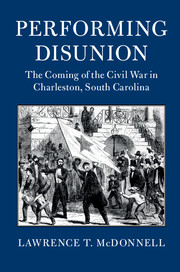10 - Men Well-Tried and True
from CONTRADICTIONS: STAND NOBLY TOGETHER
Published online by Cambridge University Press: 08 June 2018
Summary
Against this backdrop, we may return to the question of the Young Men's Secession Association parade and what it meant. There is a striking anomaly at the heart of Sam Roberts’ description of the procession. Although he sketched the march vividly, Roberts provided no names or personal details about any participants. Indeed, we have almost no information about the YMSA at all. We do not know who formed it, or when, or why. We have no indication of its size, structure, or membership, only the barest clues about leadership. There is no evidence that the group did anything before or after the evening of November 23 to further disunion, or for any other purpose. All that we have is the call it published in local papers two days before, declaring plans to tramp the city's streets of a late autumn evening, plus a handful of accounts of the march by journalists and observers. As an organization, the group left no other sign of its purpose or meaning. But that silence may be telling too.
The parade announcement opened the march to the general public, yet made clear that the YMSA would guide its course and shape its significance. “Persons desirous of subscribing” to the procession were told to leave their names at the Courier, Mercury, or Evening News offices. Designated club members would call on volunteers “to aid them in carrying out their patriotic intentions.” Whatever such a visit entailed, there must have been as much sizing- up as there was simple coordination. Disparate groups and persons had to be made to fit with the club's vision of the march. Were individuals or social or ethnic groups pushed to the rear of the column, broken up, and intermingled with other formations, or sent to the sidelines? The drive for unity and factional discipline must have exerted force here as elsewhere. Neither Roberts nor anyone else named a single person who took part as marcher or observer. The only men we know who likely appeared in the procession are J. S. Stevens, who accepted the Osborn and Durbec transparency on the club's behalf, and the parade marshals, charged with maintaining order: Samuel Mathews, Benjamin Feldmann, L. Sherfesser, and G. C. Chapman.
- Type
- Chapter
- Information
- Performing DisunionThe Coming of the Civil War in Charleston, South Carolina, pp. 208 - 226Publisher: Cambridge University PressPrint publication year: 2018



